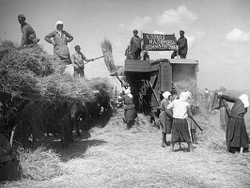
Krestanovich Alexander Nikulin about the alternative of collectivization and the fate of peasants
The ultimate goal of collectivization, carried out in the USSR in 30-ies, was a modern, industrial agricultural production by type of city. What happened to Soviet society after graduation? Was her alternative? This was stated by krestanovich Alexander Nikulin during his lecture at the Sakharov center. “Ribbon.ru” wrote down the main points of his speech.
In the late XIX — early XX century in Russia began to occur the demographic revolution. The population is increasing, especially peasant. There is a dangerous problem of agrarian resettlement, which leads to the impoverishment of the village. It is compounded by the fact that the country in this period there are still feudal remnants after the reforms of 1861: remain landed estates, than unhappy farmers periodically have ideas of land redistribution.
The events of the first Russian revolution of 1905-1907 showed that the rural population is the explosive power and need to do something. Stolypin tried to transform the peasantry on the right, through the development of capitalist farming, but not in time to achieve meaningful results. The Soviet government found a solution to this problem on the left, in a brutal collectivization.
Russian village during the Stalinist collective farm system is transformed into an internal colony, from which the Soviet government draws resources for the development of industry, science, education. For several decades farmers are considered second-class citizens without passports and salaries. The German army during the occupation of Soviet territories had not dissolved the collective farms, believing that they are highly effective machines centralized pumping resources from the village.
The collective farm system has also produced huge hierarchy of bureaucracy, which hung over the city, and above the village. In this equalization a man was deprived of what had the ordinary peasant’s own labour on their land at their discretion. People did not belong to himself, it was a complete humiliation and subordination of enormous bureaucratic elite and the disinterest in his own work.
What happened to the village after collectivization
During collectivization, many people, especially young people, believed in socialism, that out of poverty they will create a socialist future, and many very sincere and worked selflessly. Doubting socialism were expecting draconian measures of the Stalinist state. Corrosion of this peasant-collective-farm socialist morality comes in the 1960-ies.
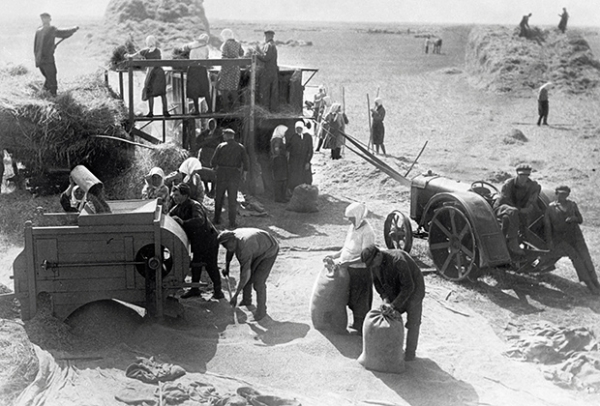
Threshing of the first harvest of the collective farm during the collectivization
Photo: Max Alpert / RIA Novosti
It is sometimes said that the great blow against the peasants caused by Stalin in 1929-1930. But no, peasant ethics and culture largely survived until the early 1960s. it was at this time the old type of peasant, conscientious, and even carefully applied to the collective good, rooted in the past. Occurs pozdneatlanticheskii a day labourer, often alcoholic type who doesn’t care where you work, in the village or in the city. There is a mass Exodus of peasants to cities, the village is dying, its population is degrading — is the reservation of old ladies and their sons-of alcoholics.
After collectivization was that the peasantry was very tenacious that it is, despite all the disasters that have disappeared slowly over several generations. Experience shows that the possibilities for transformation and development of the rural population, if the case give the correct move.
We now have many bite your elbows and say that, if in the USSR in the late 1950-ies was our Deng Xiaoping, which would provide an opportunity to market the socialist development of the countryside, then the Soviet economy and the village pulled as well as pulled China in the 1980s and 1990s. But Nikita Khrushchev was a romantic, believed in the benefits of mega gosudarstvennogo agricultural production. He is Orthodox, though not heinously in the Stalinist, and believed that in rural areas, large industrial best peasant family that needs lime to finish.
As a result, we got what we got. In the 1970-ies and 1980-ies because of the flow of petrodollars, the Soviet authorities began to generously Fund the development of collective and state farms, and still rural dwellers with nostalgia for the Brezhnev era, assuming that this was the Golden age of the village.
At this time, finally, investments in agriculture, and if Stalin wanted the village to invest less and to withdraw from her more, then there is the Soviet power seemed to return his debt. Indeed, those same members of the Brezhnev Politburo were almost all peasants ‘ sons, remember this village, and from oil windfalls increased the investments in the collective and state farm production and construction.
But as the scheme of agrarian governance was an old, bureaucratic, without initiative, and their impact was small. Hence was born the metaphor of Yegor Gaidar that the village is “black hole” of the agro-industrial sector, inefficient and unnecessary. In the 90-ies, when I finished this generous Soviet funding from petrodollars, there was a terrible recession and in many ways, the collapse of post-Soviet agriculture. In the late 1990-ies according to its characteristics it is returned only to the level of the early 1960s.
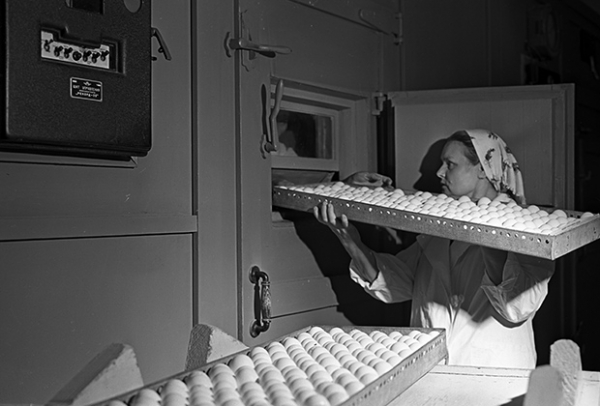
Poultry farm worker lays eggs in the incubator. The farm “Gorki-2” Moscow region, 1960.
Photo: V. Noskov / RIA Novosti
Moreover, this age-old bet on the mega agricultural production there now. There are supporters of agricultural progress, who say that giant capitalist holdings all by themselves adjust that they are the main way of progress for Russia. However, if everything is fine, then why does the rest of the world does not go on this way? Still even in the USA, and especially in Europe, the basis of agricultural production is the farmer who is in many cooperatives working on actually chanovskiy model family farms.
The farmer as a human type in Russia did survive, survived, just now it is a “rare bird.” If in 1920-e years farmers have been 100 million people, now, in my estimation, their tens of thousands. Plus, of course, remains, fragments of peasant mentality dispersed and dissolved in the millions of modern city dwellers-villagers who so appreciate and love the rural-suburban-rural lifestyle.
To some extent, now peasant ideals are being revived in Russia. They connected with the ideas of new ecology, the new (old) relationship between man and nature. For example, in the recent work of the Dutch Professor van Der Ploge “Chanowski Manifesto” argues that the ideals of family agriculture in the modern economy, science and technology get a second wind.
Was there a predefined Stalin’s collectivization?
It is believed that such rapid collectivization and industrialization justified by the fact that otherwise the USSR is not prepared for war. But it is a subject of eternal dispute in historical scholarship. Opponents of alternative visions of history they say that history is rigidly deterministic, impossible to change anything.
In my opinion, in this question the large role played by the subjectivity of political figures, specific features of political struggle, which was not predetermined the victory of Stalin. As for the so-called right-wing, they were unlucky, they didn’t have such a crafty and experienced politician. Bukharin was a child in political and administrative intrigues in comparison with Stalin.
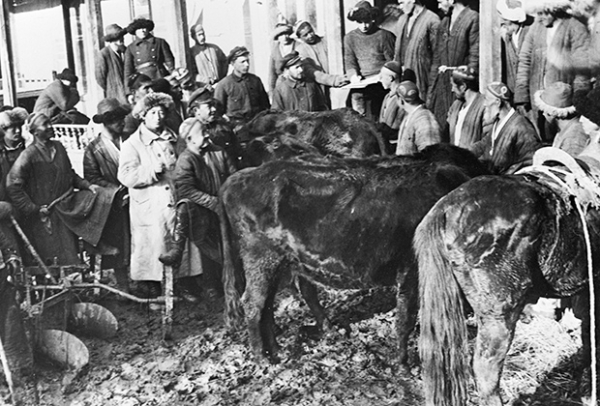
The village Council Chairman Isaac Ajibekov (left in white) participates in the distribution of cattle between Baia village residents
Stalin was a brilliant cristianorolim. He loved to read the works of the German military theorist Clausewitz, who wrote that the enemy should inflict such a defeat that several generations to discourage him to a new struggle. The Soviet leader was able to overcome and break the great, vast and ancient social class in the country.
There are mathematical models that applies to, what it would be like if everything has been evolving and gradually. First, there would be such a giant leap in the growth of heavy industry and the failure of agriculture and light industry. Economic results of a mathematical market model of the NEP for the development of socialism by 1940 would be approximately the same as in Stalin’s Russia, but without the monstrous hunger and lowering living standards.
When Stalin conducted in 1937-38 census, he was angered to find “unexpected” decline in the population of several million people from starvation and repression, and he hoped that he was all and everywhere increasing. According to Theodor Shanin (Professor, President of Moscow school of social and economic Sciences — approx. “The tape.ru”), had the USSR not developed through the bureaucratic terror of collectivization, and market through the cooperation of the peasantry, the Red army would stop the Germans somewhere near Smolensk.
Others argue with this and I doubt would be enough if industrial resources for the future, because Stalin had prepared immensely and tanks, and aircraft. But in the mass they to 1941 was outdated, poorly managed and vulnerable, so much had to start all over again.
The price of progress
Now there are a number of modern Russian and even Western liberal historians, who generally believe that collectivization was a success: the industrialization spent, the war was won. There are appropriate economic and statistical calculations, according to which Soviet Russia was in a condition typical of third world countries: a lot of peasants, it is necessary to industrialize. Eventually, the USSR pulled forward, created a huge industrial power, people received General education, in 1961, launched Yuri Gagarin into space.
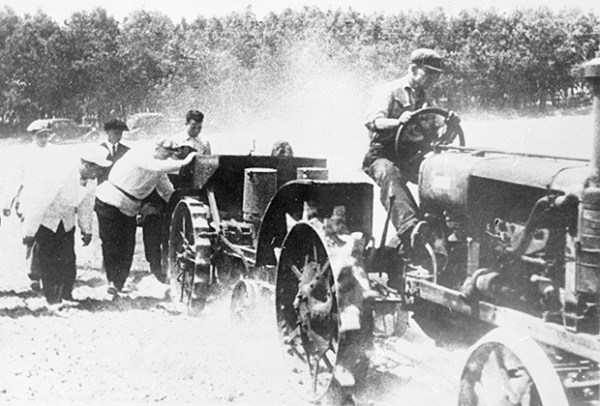
First Secretary of the Communist party(Bolsheviks) of the Ukraine, Nikita Khrushchev (center) during the test on the potato field of one of the farms
Photo: RIA Novosti
But at what cost? In response, hinted that it all happened by Malthus. There was the problem of agrarian overpopulation, Soviet peasants had too much to do with them was nowhere from the point of view of rational progress, extra mouths to feed, strangers at the feast the elect to new life. Wanted — not wanted Stalin, and five million people died during collectivization, another twenty million extra mouths perished in the great Patriotic war. So the Soviet Union was freed from the burden of agrarian overpopulation, instead of getting machine socialist industrialization.
In my opinion, all of this cannibalistic samples-progressive worldview inhumane by those who believe in the name of world revolution and world progress, you can commit any crime. From the point of view of this macroprograms all these victims of collectivization — it happens in history all the way. The main thing, more or less ended well. But is it over? Fatally dull emptiness of modern rural-urban spaces of Russia is the main legacy of collectivization, which our politicians will not put the mind what to do.
Alternatives of Stalin’s collectivization
In the early XX century in the Russian Empire were the three great matter: the work, the national and agrarian, and the last was the most difficult and popular. In Russia there were a huge number of agrarian parties, their programs, brochures on the agrarian question.
In my opinion, would be preferable to the alternatives of anasov (popular socialist party) that were the most peace-loving wing populists. They planned to bet on the peasantry and the development of its economy in the market-co-operative forms, as we have said, the “green revolution”. But in conditions of fierce war and class struggles of 1917 this was unrealistic.
In the 1920s, he proposed three main alternative political program prior to collectivization. First, it is a point of view that existed among left-wing Communists, formulated by Trotsky and Preobrazhensky. They agreed that the peasantry need to squeeze all the juice of industrialization, but through the strengthening of its market taxation.
Secondly, was the bourgeois-liberal point of view, the so-called old Russian professors, in the person of Nikolai Kondratieff and Lev Litoshenko. They said that we should not frighten the country by a fist, it is necessary to develop market economy, to bet on that the fist is a large farmer. The development of such rural-fermerskogo of capitalism will lead to rapid growth of the entire economy. But opponents of this idea thought it was dangerous: to begin again the operation, will increase rural poverty, the bourgeoisie, first in rural, then urban, which will overthrow Soviet power.
There was also a socialist point of view Bukharin and Chayanova, offered to bet not a bourgeois farmer, as proposed by Kondratyev and Litoshenko, and on average the cooperative peasantry. Farmers would be included in a special large and small industry cooperatives that operated on a market basis. Thanks to the development of cooperation would develop in General the peasantry, non-capitalist, prestasie in socialism and providing for development of sufficient resources.
Why this plan didn’t work? Critics said that it’s all good, and they even agree with these ideas, but in practice a little that are able, agricultural development is not fast enough. In fact, such a peasant cooperative socialism Chayanova — Bukharin was far from smooth because of the party and bureaucratic control over the freedom of market activities farmers, rural cooperatives and organizations. Peasants and peasant cooperatives, being rigid authoritarian control of the party bureaucracy, had enough freedom for the manifestation of economic independence and initiative.
Here it is necessary to mention also about the experience of building socialism and collectivization in other countries. After the war, a whole system of world socialism and collectivization was carried out in most of the socialist countries. The Soviet example was followed by many States of the socialist camp. Almost everywhere collectivization was implemented, but still less cruel. With incredible cruelty it was conducted primarily in the USSR and partly in the years of the great leap forward in China (this experiment there also led to immense hunger).
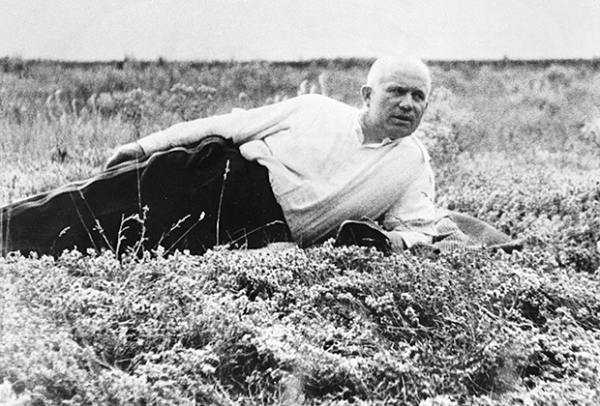
A member of the Military Council of the 1st Ukrainian front N. With. Khrushchev in the Donetsk steppe
Photo: RIA Novosti
In addition to the Baltic States, Western Ukraine and Belarus, collectivization was carried out in Hungary, Czechoslovakia, East Germany, Romania, Bulgaria, Albania and partly in Yugoslavia. In Poland it provoked strong protests from the peasantry. Poland, perhaps, was the only Eastern European country where there was only a small number of state farms to state-owned enterprises. Basically it remained a peasant, not collectivized.
In all socialist countries, the farm was less productive compared to forms of family or peasant farms. In the later stages of socialism have sometimes been very promising agricultural experiments. Sometimes a socialist government seriously tried to interest in mutual cooperation, collective and private farms, so they are not mutually Rob each other as competitors, and to the member of the socialist agricultural cooperative was interesting and profitable to work in the public workplace and in their personal farms.
The most successful form was developed by Hungarian cooperatives 1970-1980-ies, janowskie successfully used the ideas of integration and large family and cooperative agricultural production. Then there was the so-called Hungarian miracle. It turned out that these socialist farms are quite competitive even with Western forms of farming.








